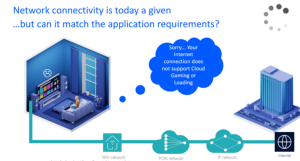 “Automation is inevitable”, Nokia Head of End-to-End AutoX Solutions & Innovations Kurt Pynaert advised. “And it can be used to monetize and optimize networks.” The combination of end-users becoming more demanding alongside BSPs wanting to differentiate their service offerings means that intelligent automation must be embraced.
“Automation is inevitable”, Nokia Head of End-to-End AutoX Solutions & Innovations Kurt Pynaert advised. “And it can be used to monetize and optimize networks.” The combination of end-users becoming more demanding alongside BSPs wanting to differentiate their service offerings means that intelligent automation must be embraced.
During the presentation, Pynaert spoke about the TM Forum’s work with autonomous networks and how it helps drive operational efficiency and business growth.  Within TM Forum, there is a well-defined framework and methodology to evaluate the level of autonomy, and this describes the necessary concepts and principles for the future network reference architecture.
Within TM Forum, there is a well-defined framework and methodology to evaluate the level of autonomy, and this describes the necessary concepts and principles for the future network reference architecture.
There is not a one-size-fits-all approach to cater for the QoE of every end-user, Pynaert said. Each customer, whether that be smart home, enterprise, or industrial, has differing requirements. Customers have varying network needs, such as latency, reliability, bandwidth, or mobility.
Pynaert advised that intent-based network slicing offers an end-to-end solution that delivers services with a service level objective (SLO) that goes beyond QoE. These SLOs can be a variety of speed, latency, reliability, security, and can cater for the likes of cloud gaming, the home office, education, health, and enterprise. The dynamic network slice can be paid for by the application provider or end-user for the premium service.
According to Pynaert, autonomous network slicing is a reality today. The industry is evolving at an exponential rate, transitioning from software defined networks to autonomous networks enabled by multi-vendor domain controllers. The reference architecture of autonomous networks from TM Forum provides cross-domain collaboration, decentralized intelligence, intent-driven open interfaces, and decoupled operational layers.
Pynaert stated that Artificial Intelligence (AI) will help us greatly in the quest for greater network automation. The adoption of AI can help configure, assure, optimize, and identify which requirements are needed for each service. The domain controllers can have closed loop automation through AI and adjust to the network according to expectations.
Pynaert closed with a message, “humans are still needed in the operations of autonomous networks. However, humans are now ‘on the loop’ operational supervisors rather than ‘in the loop’ bottlenecks to automation.” Autonomy is set to play a key role in the years ahead as our networks start sense, think, and act autonomously and deliver the high-quality QoE that end-users crave.
